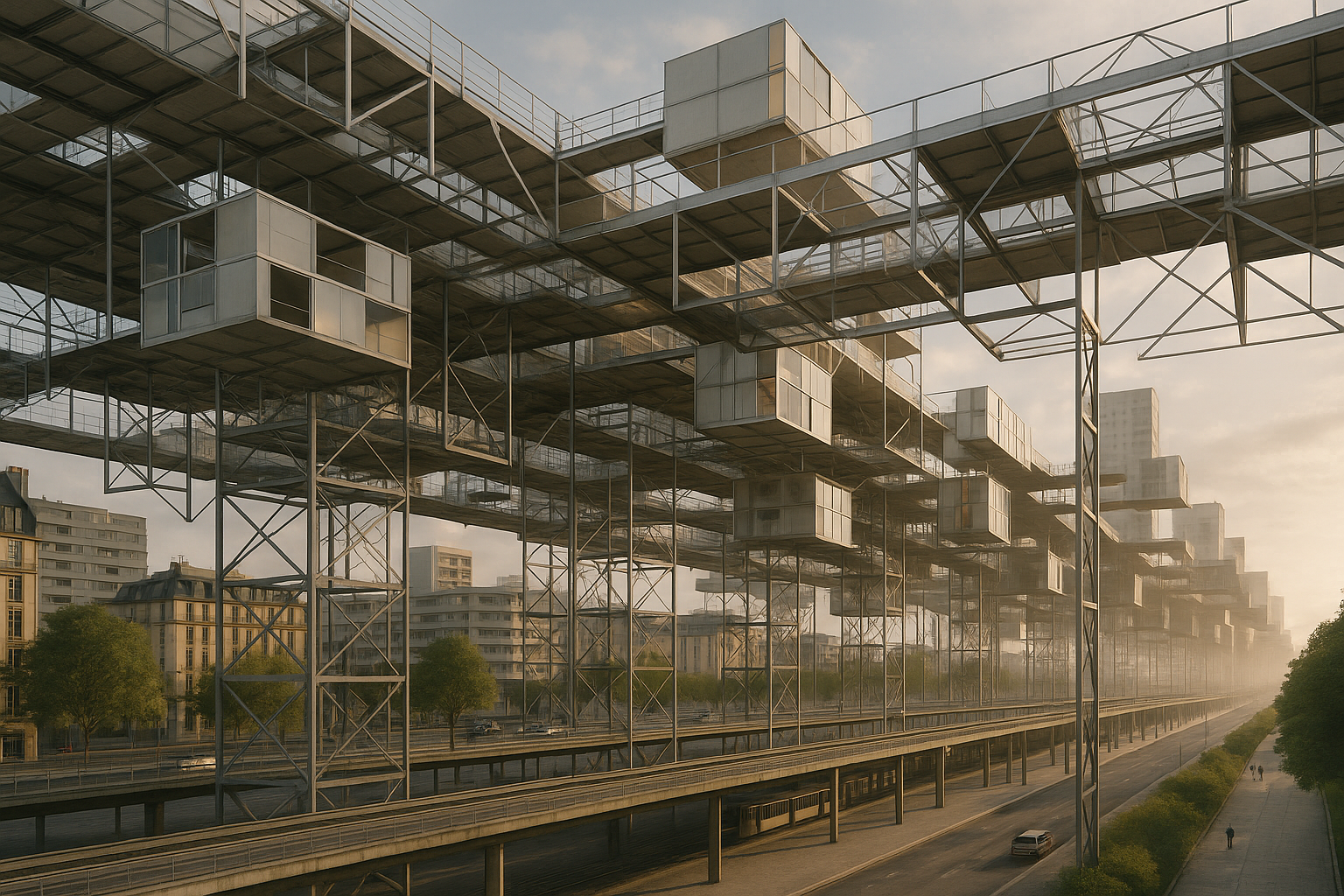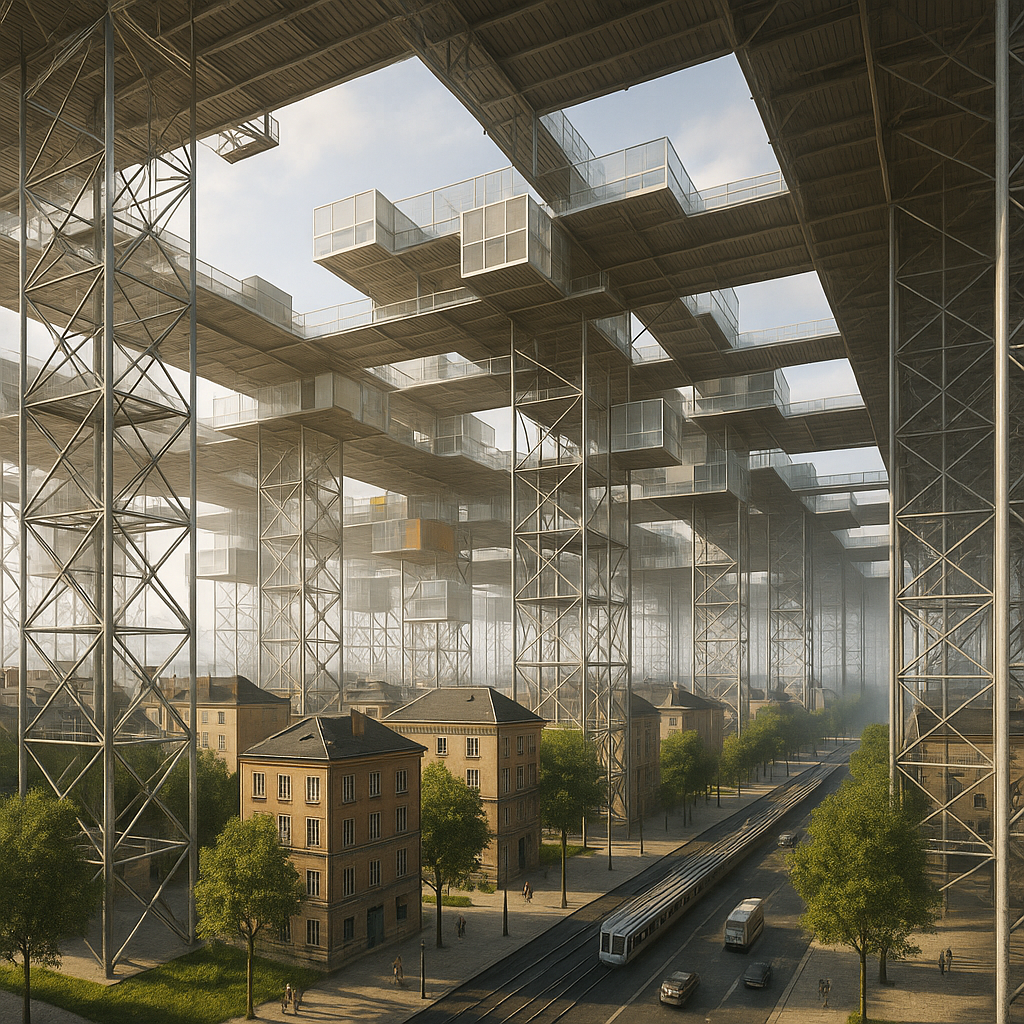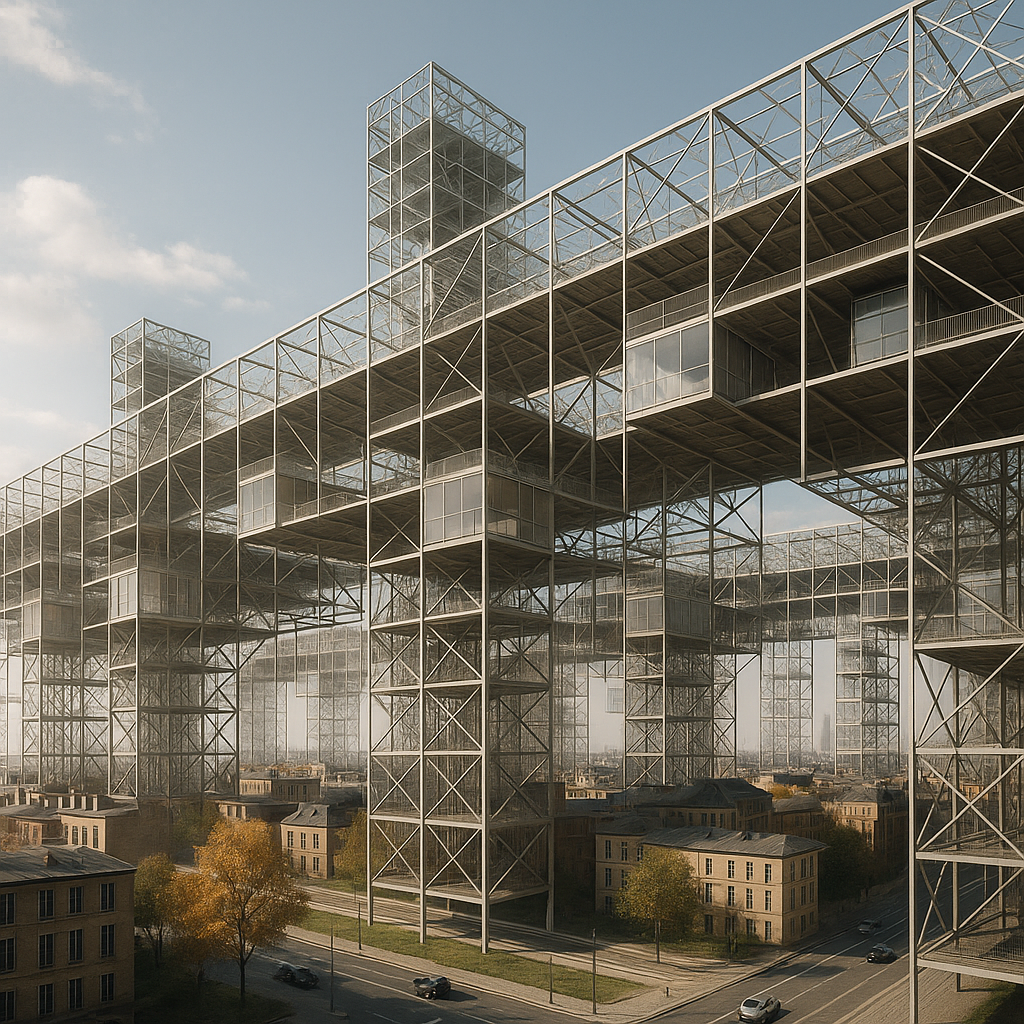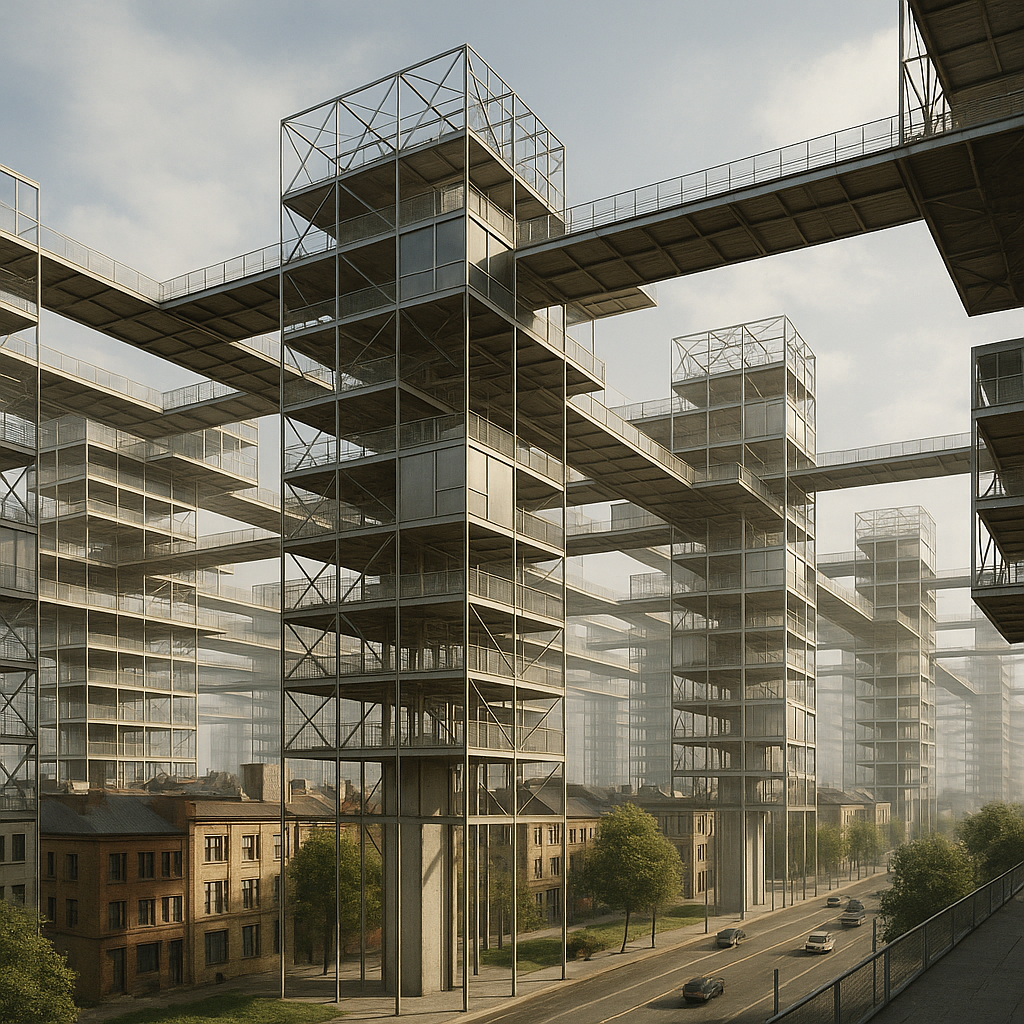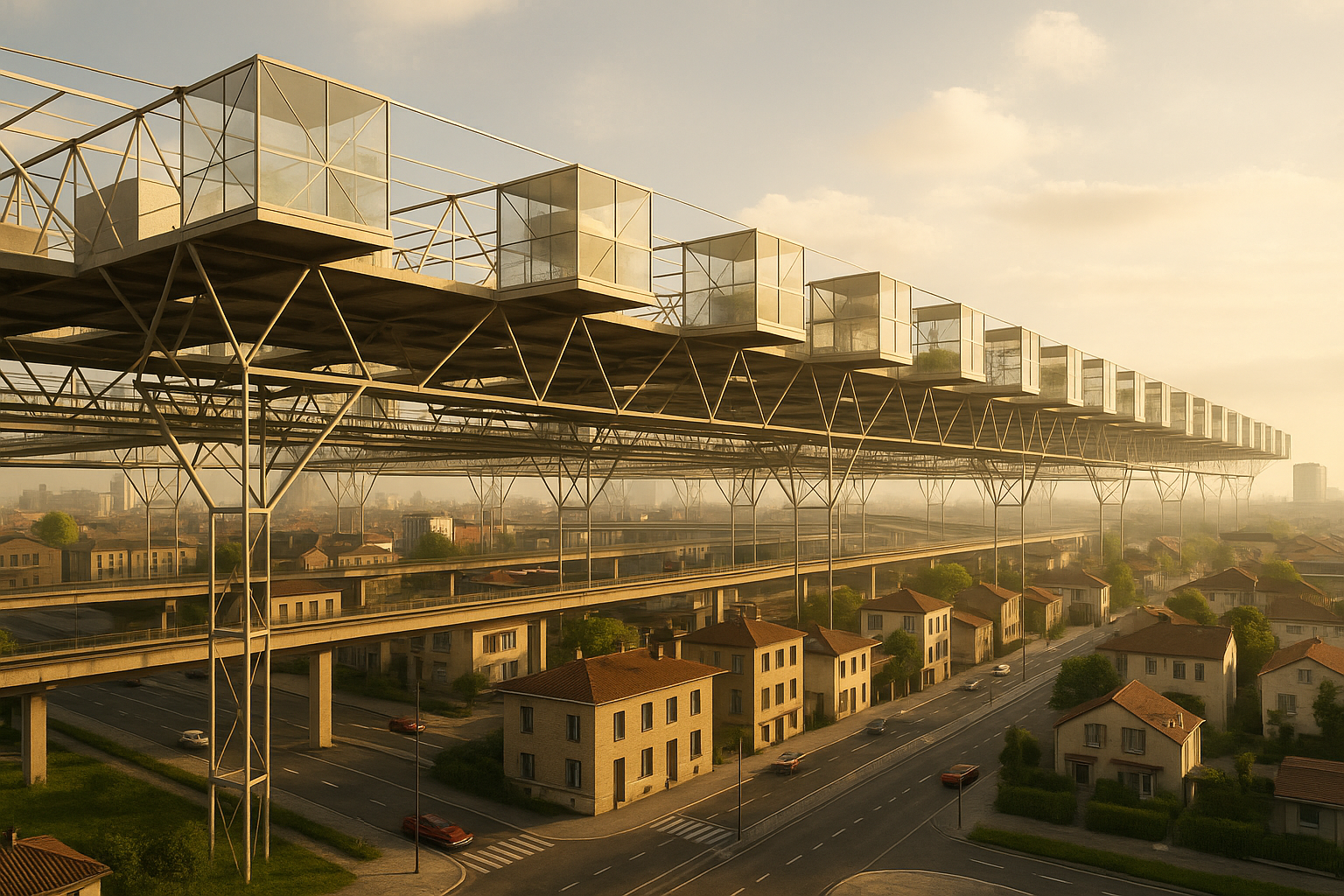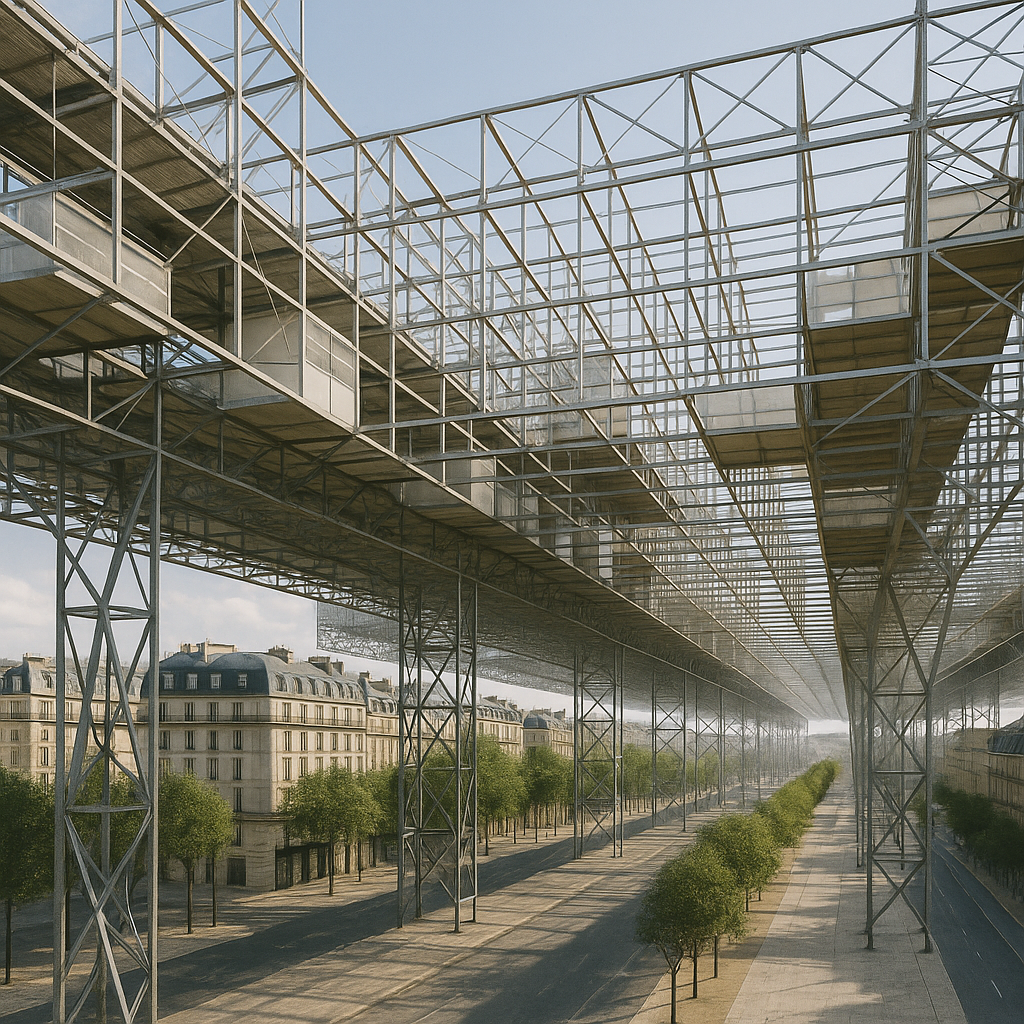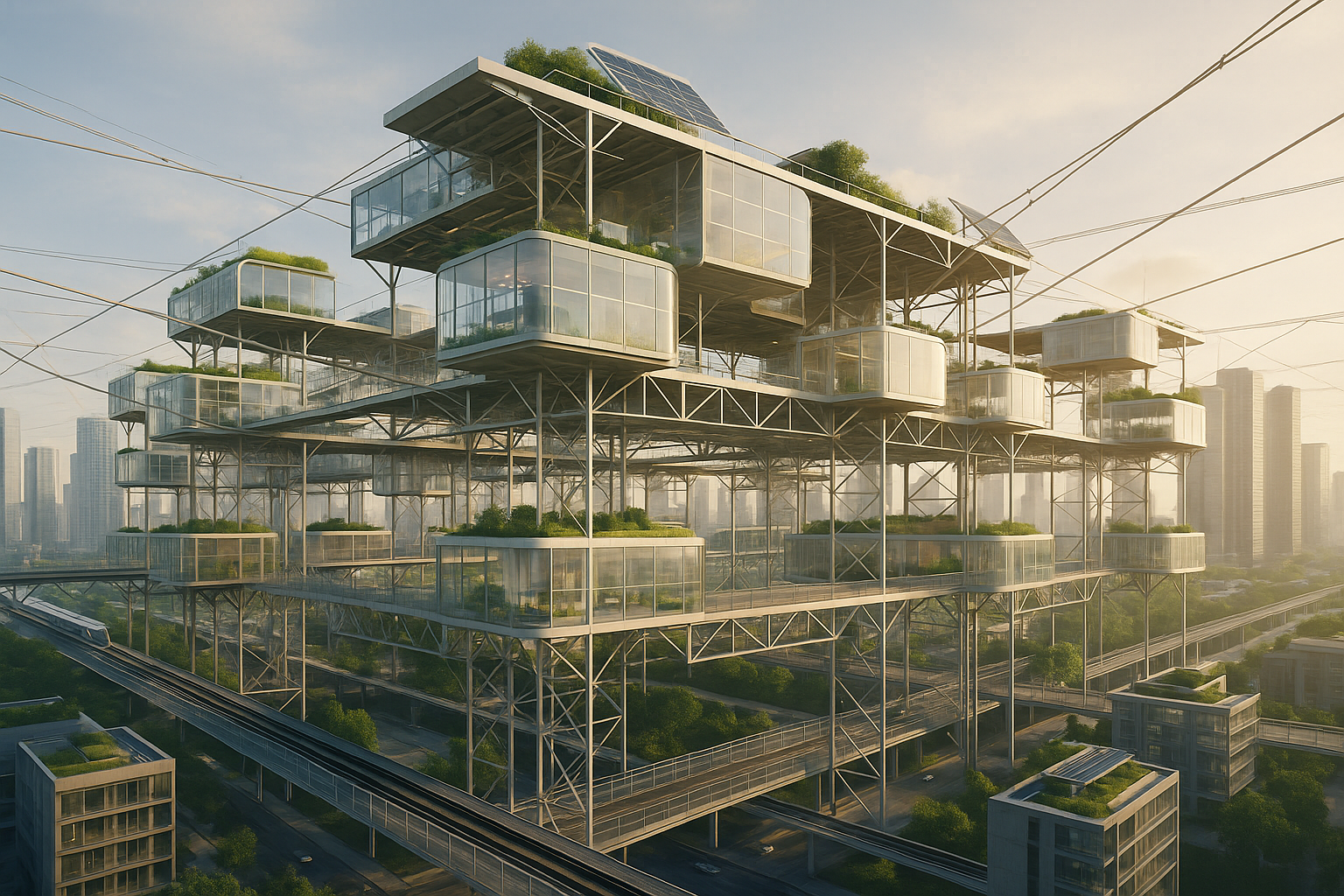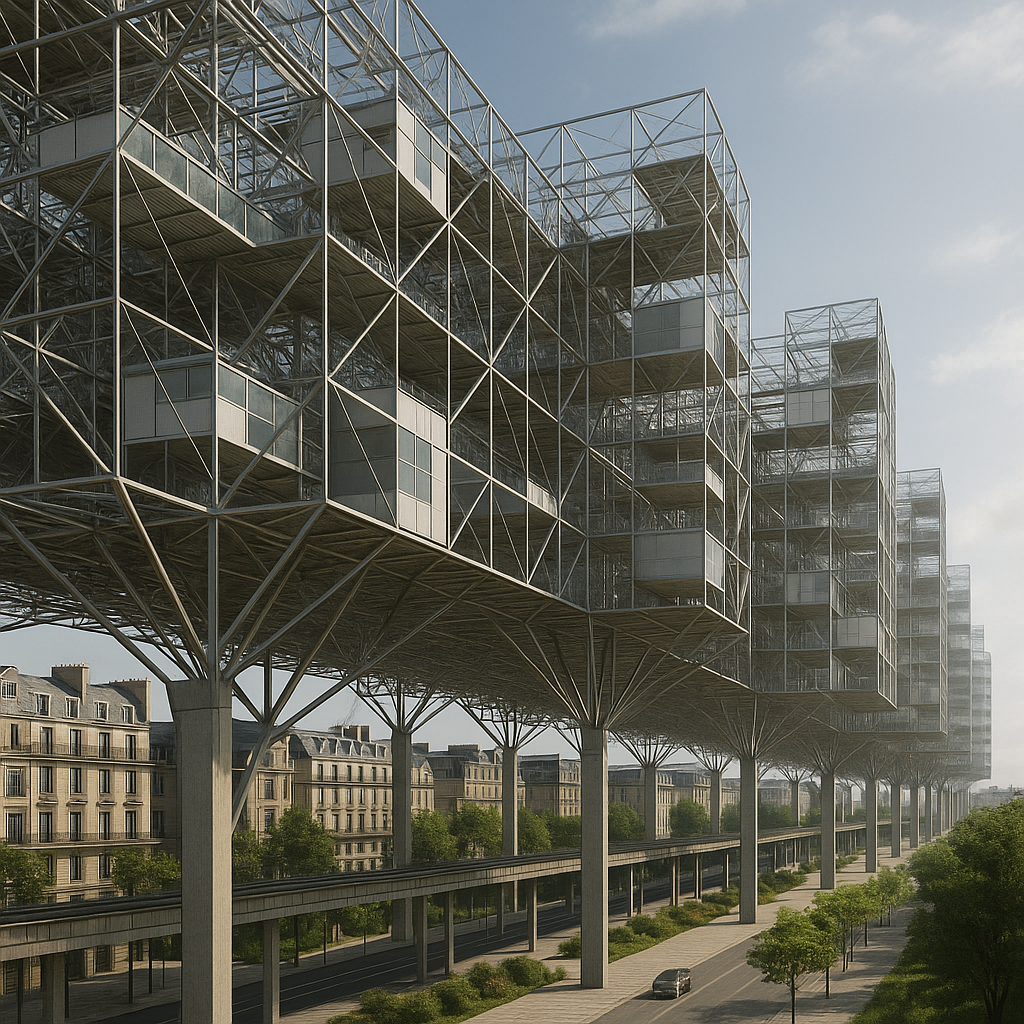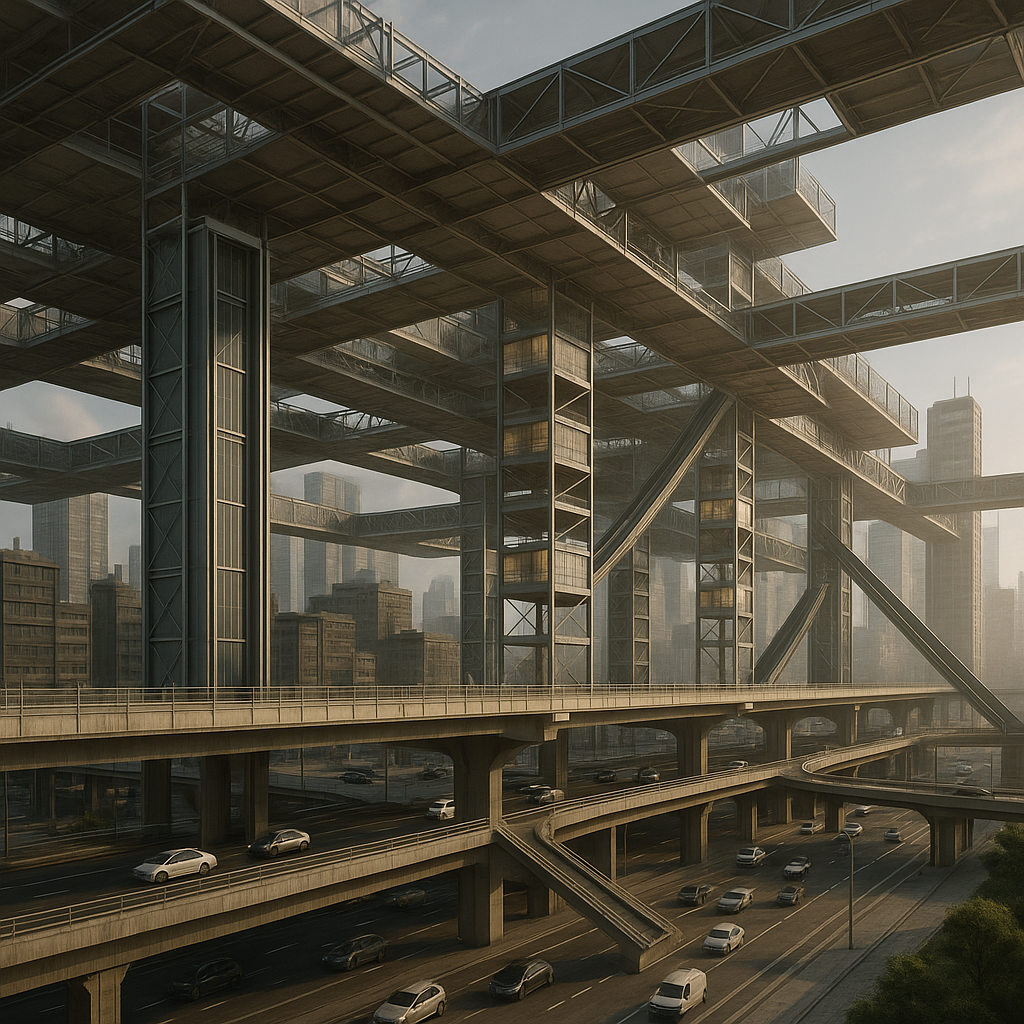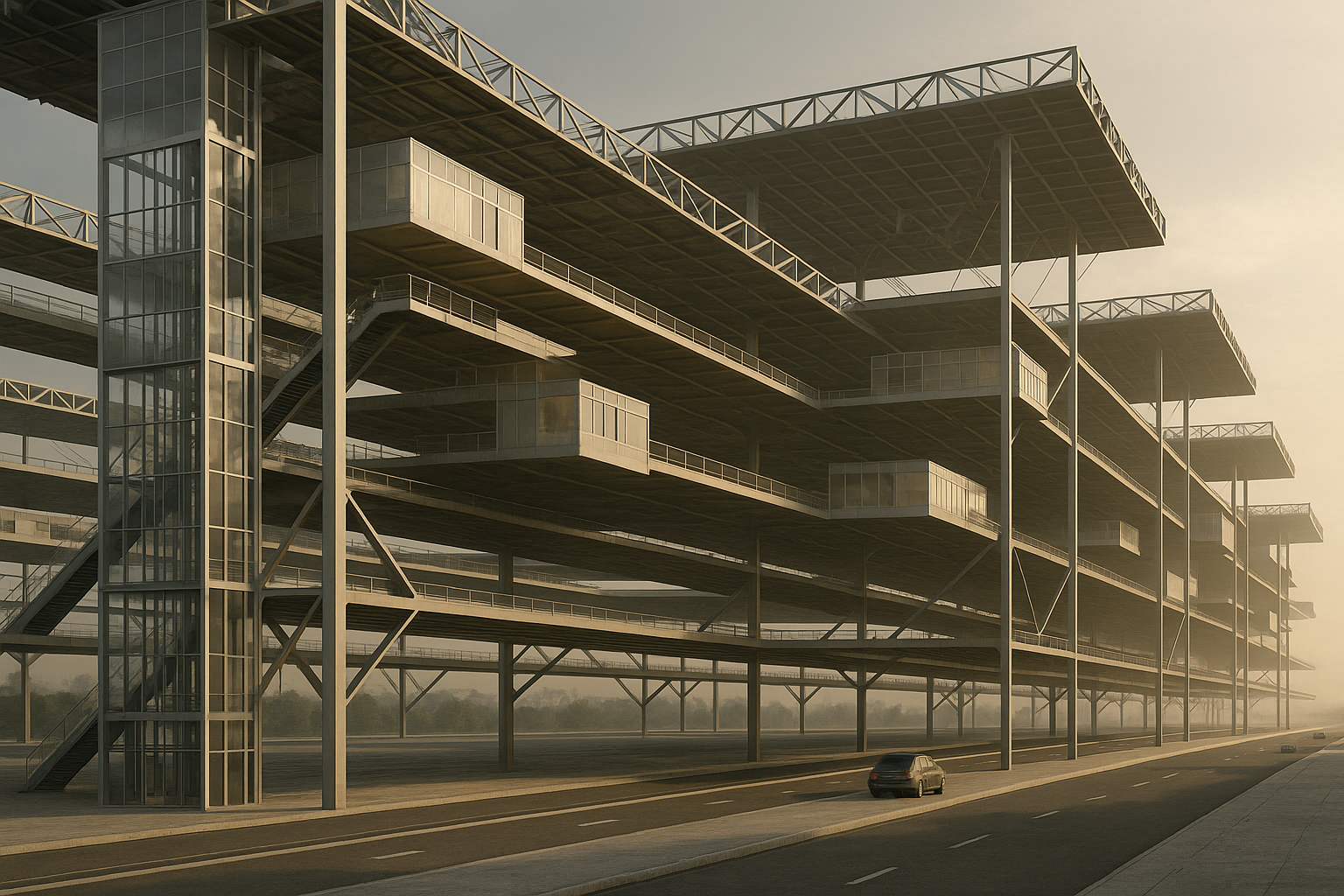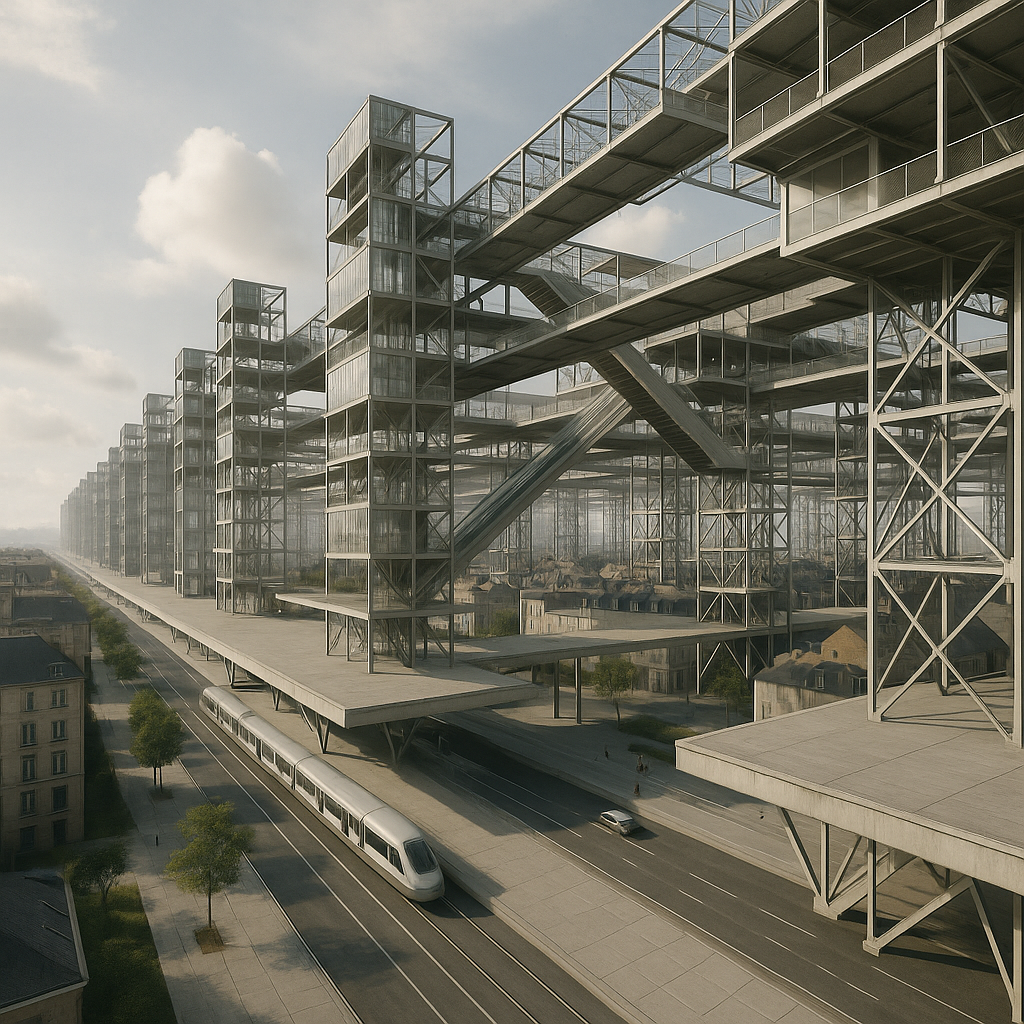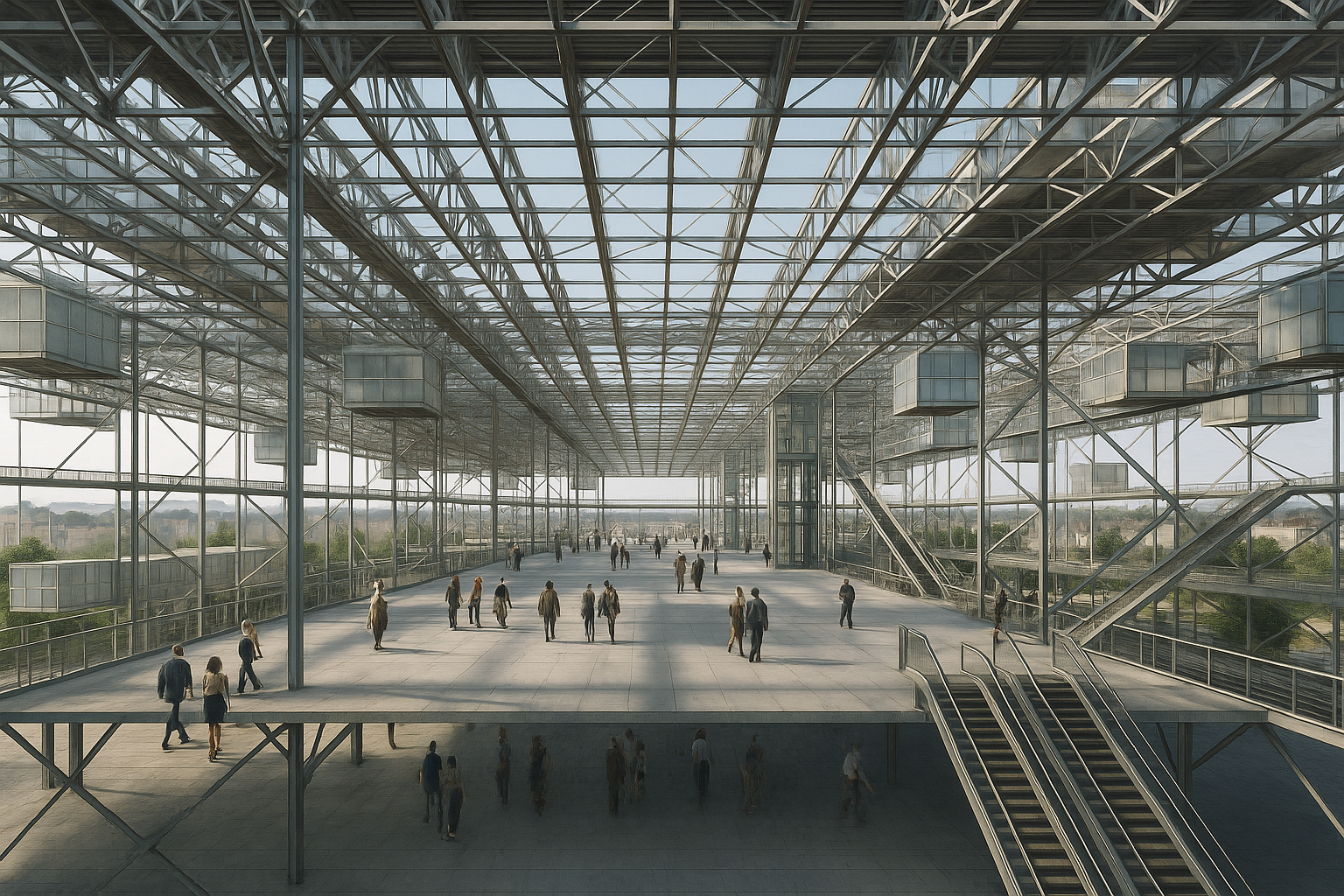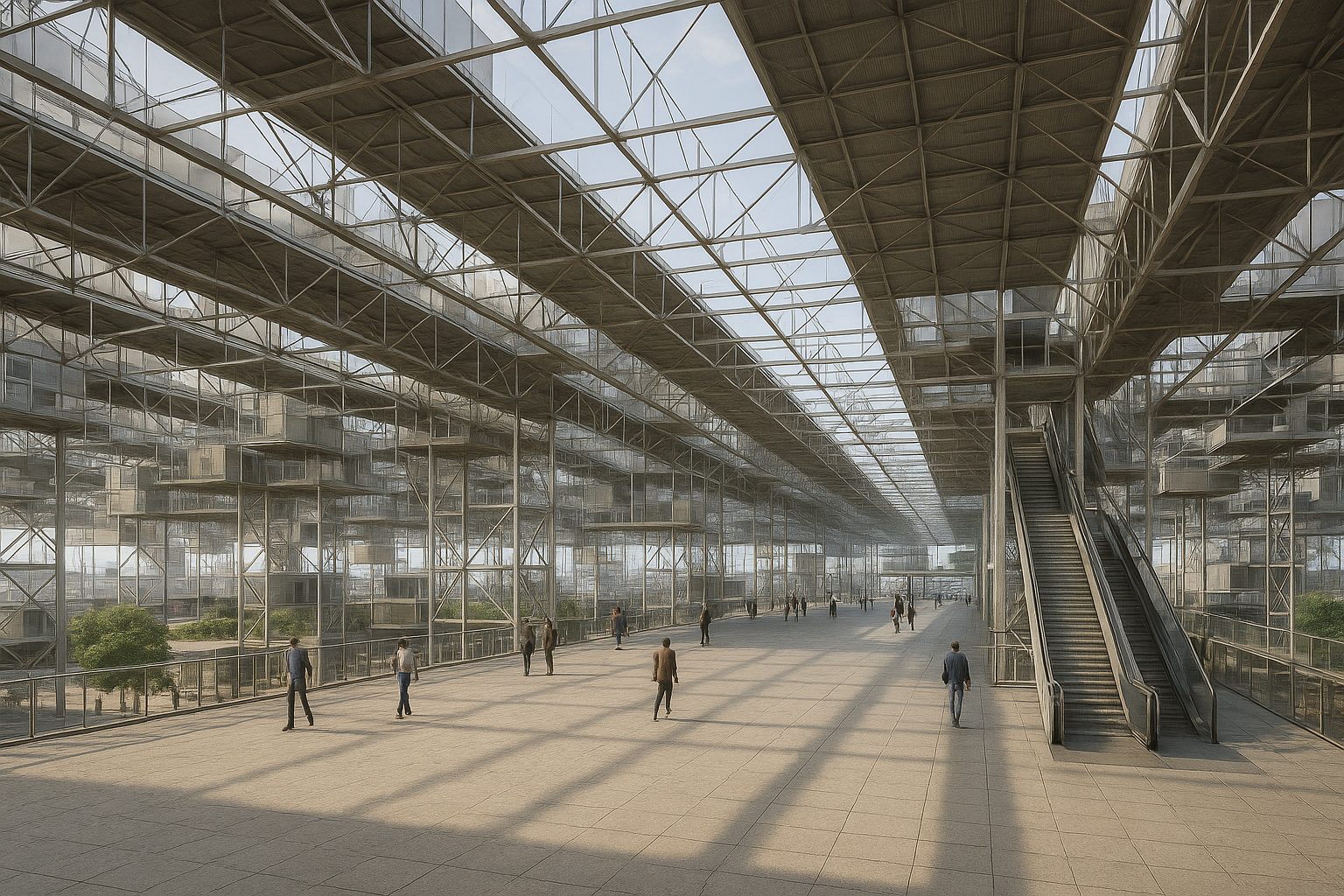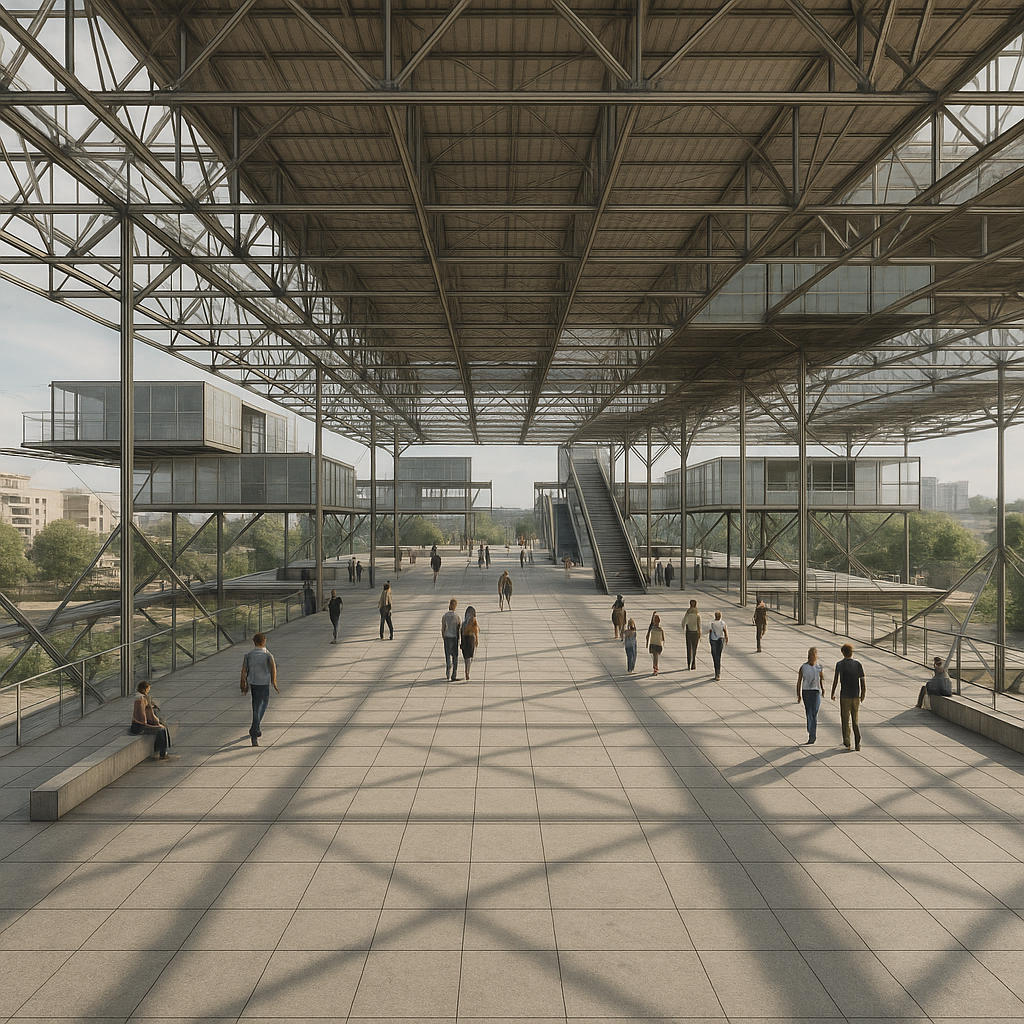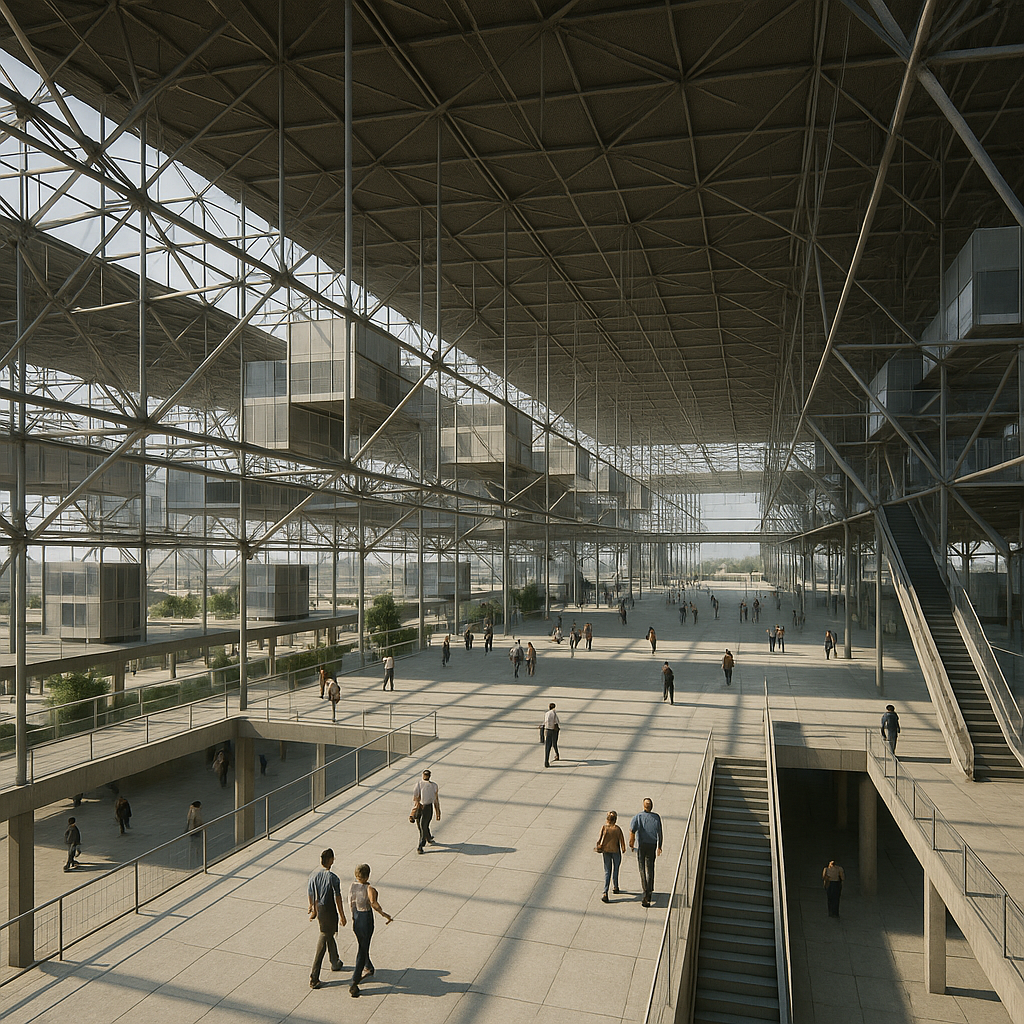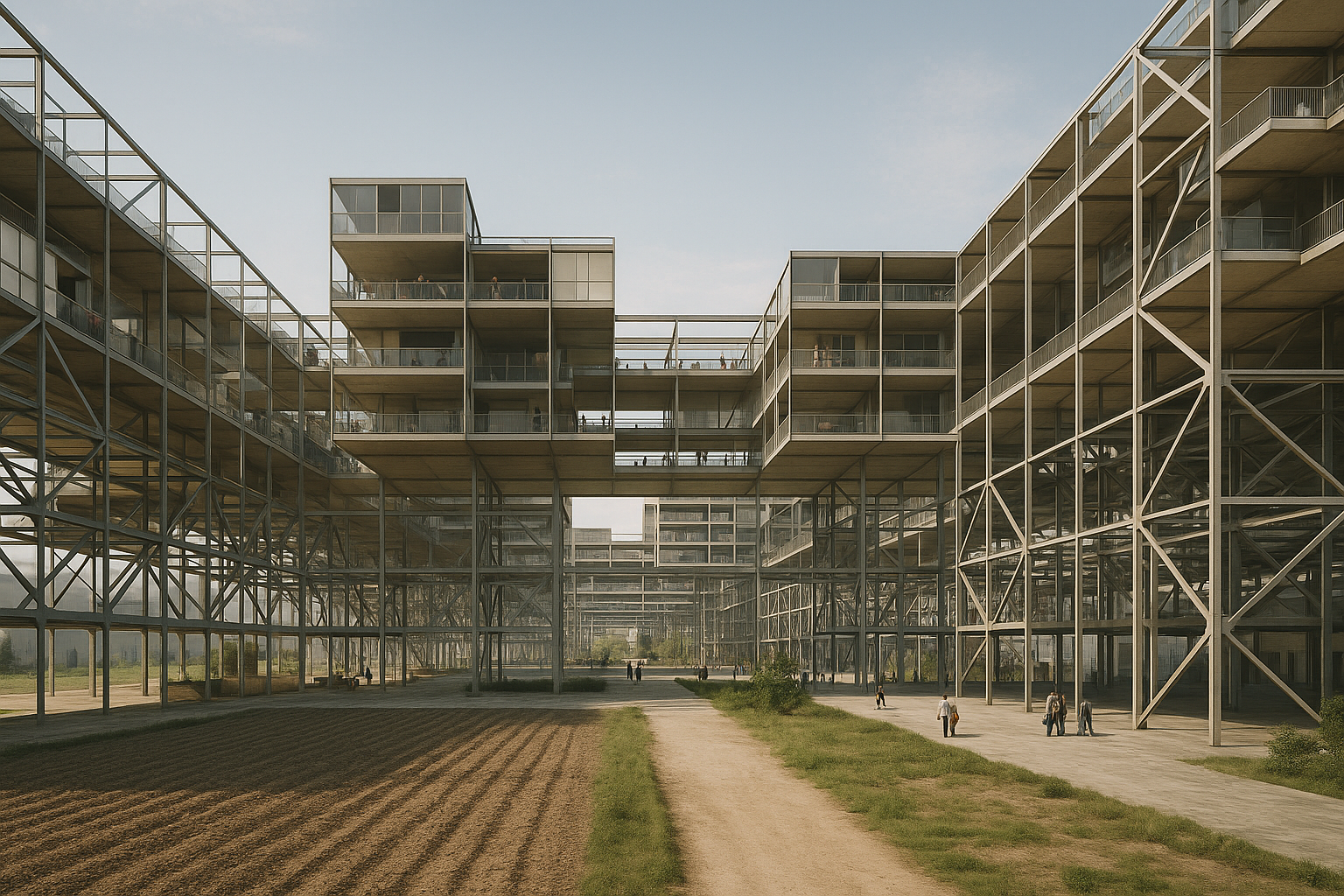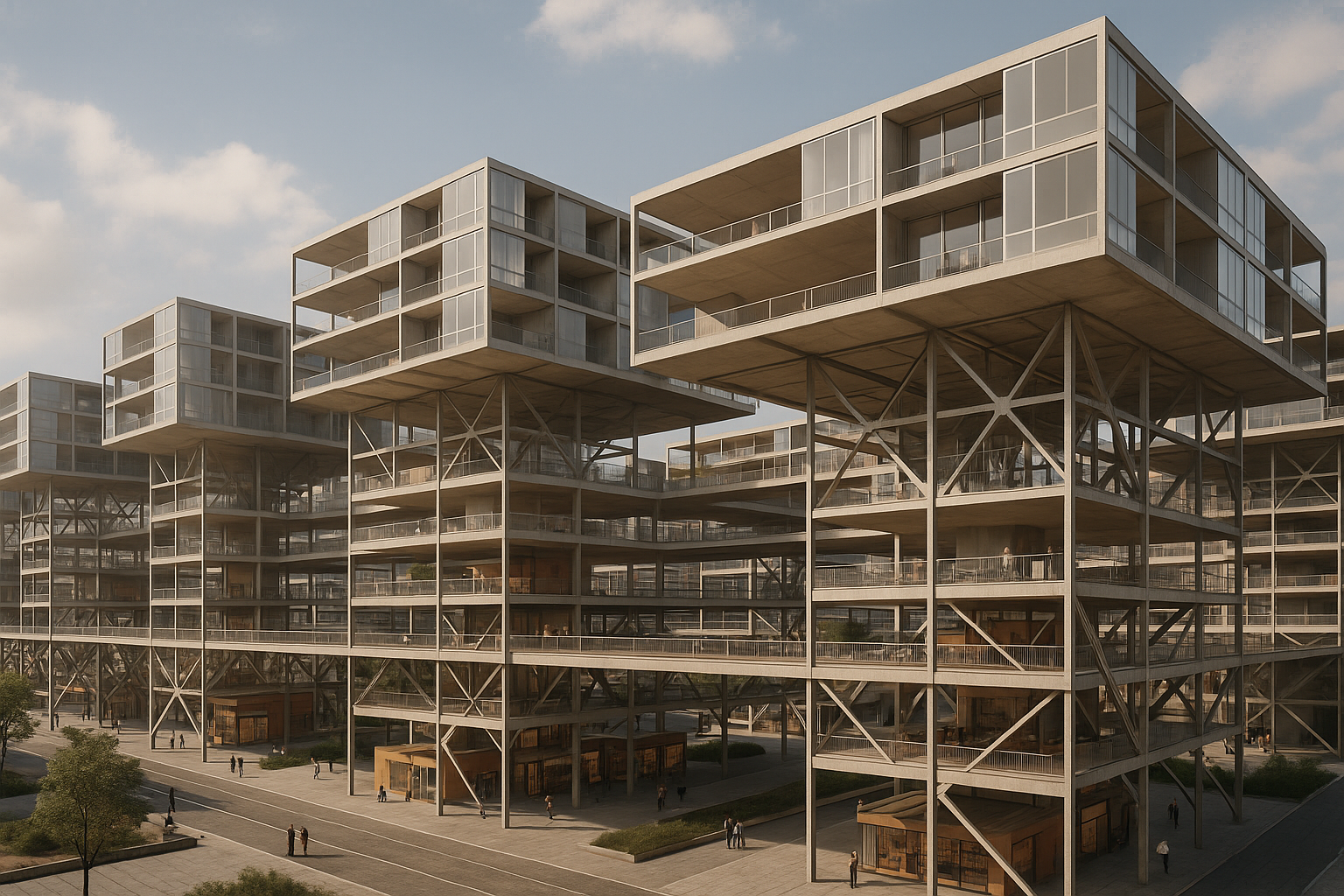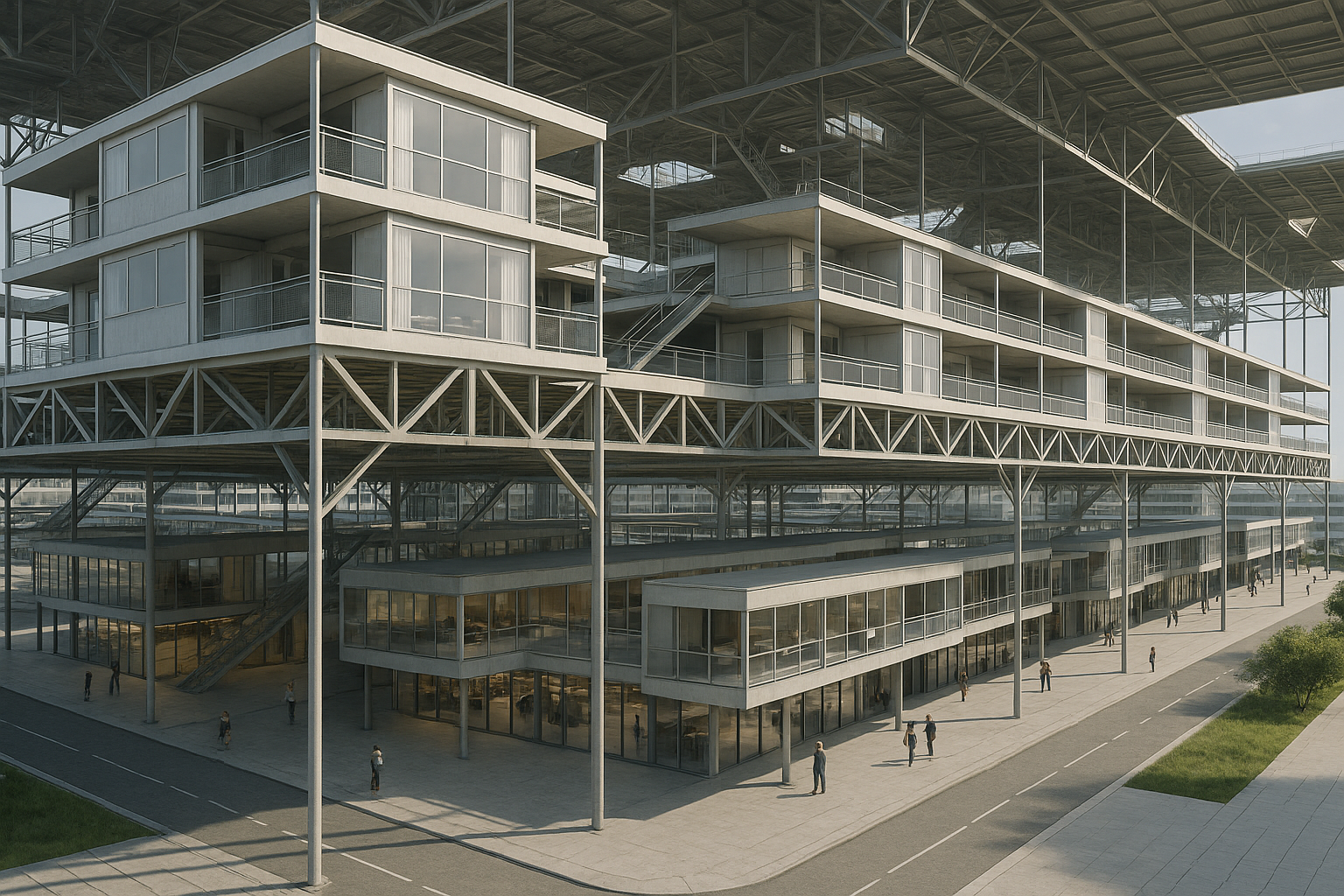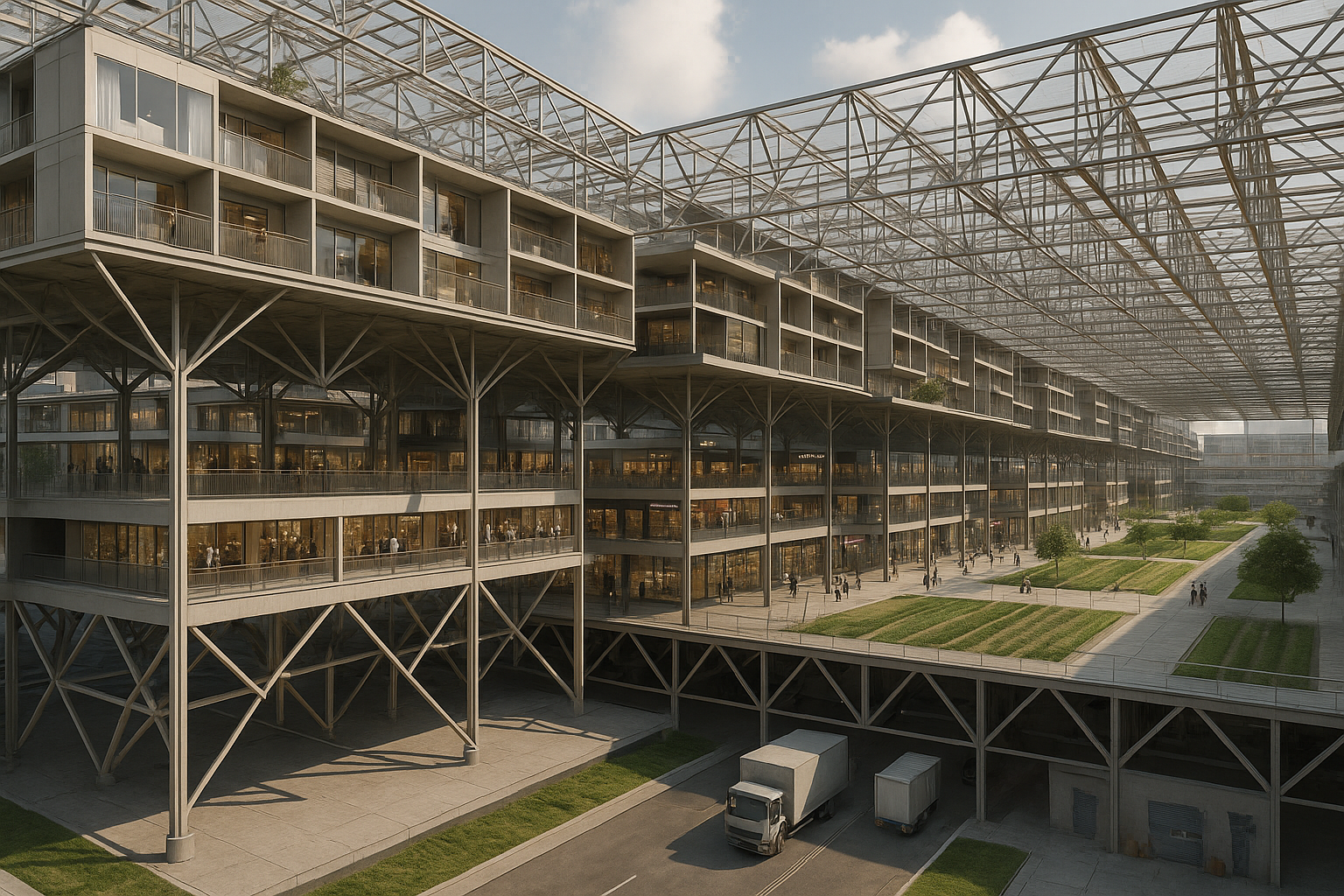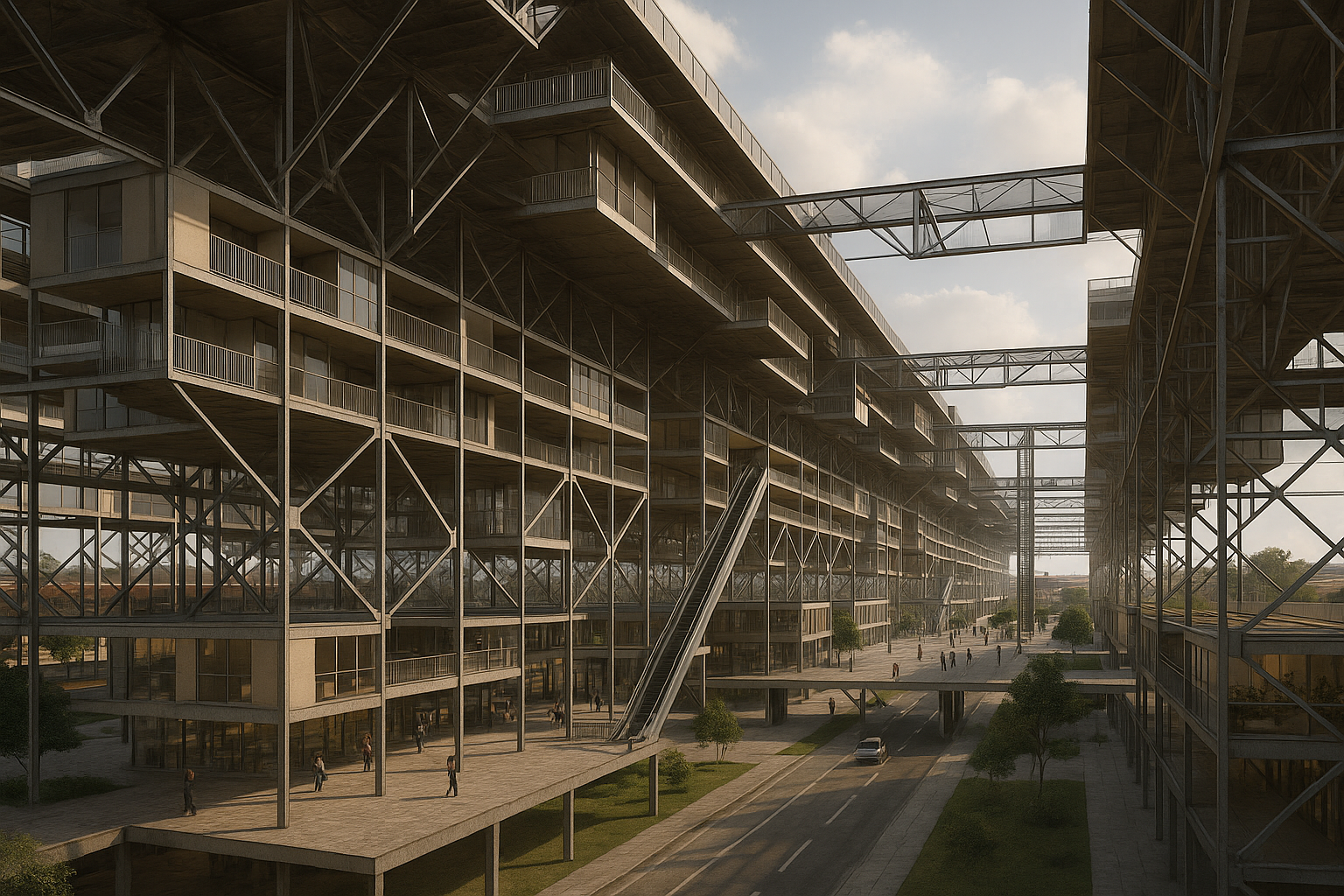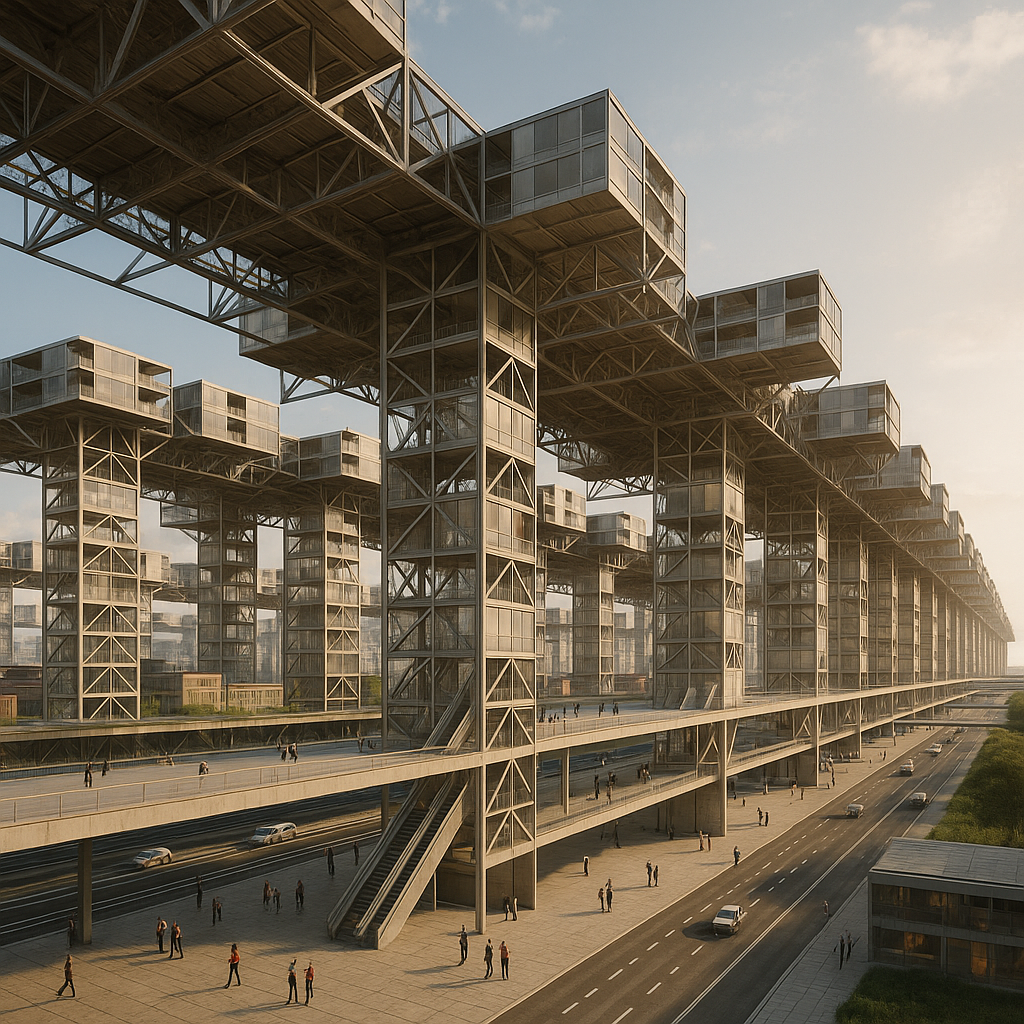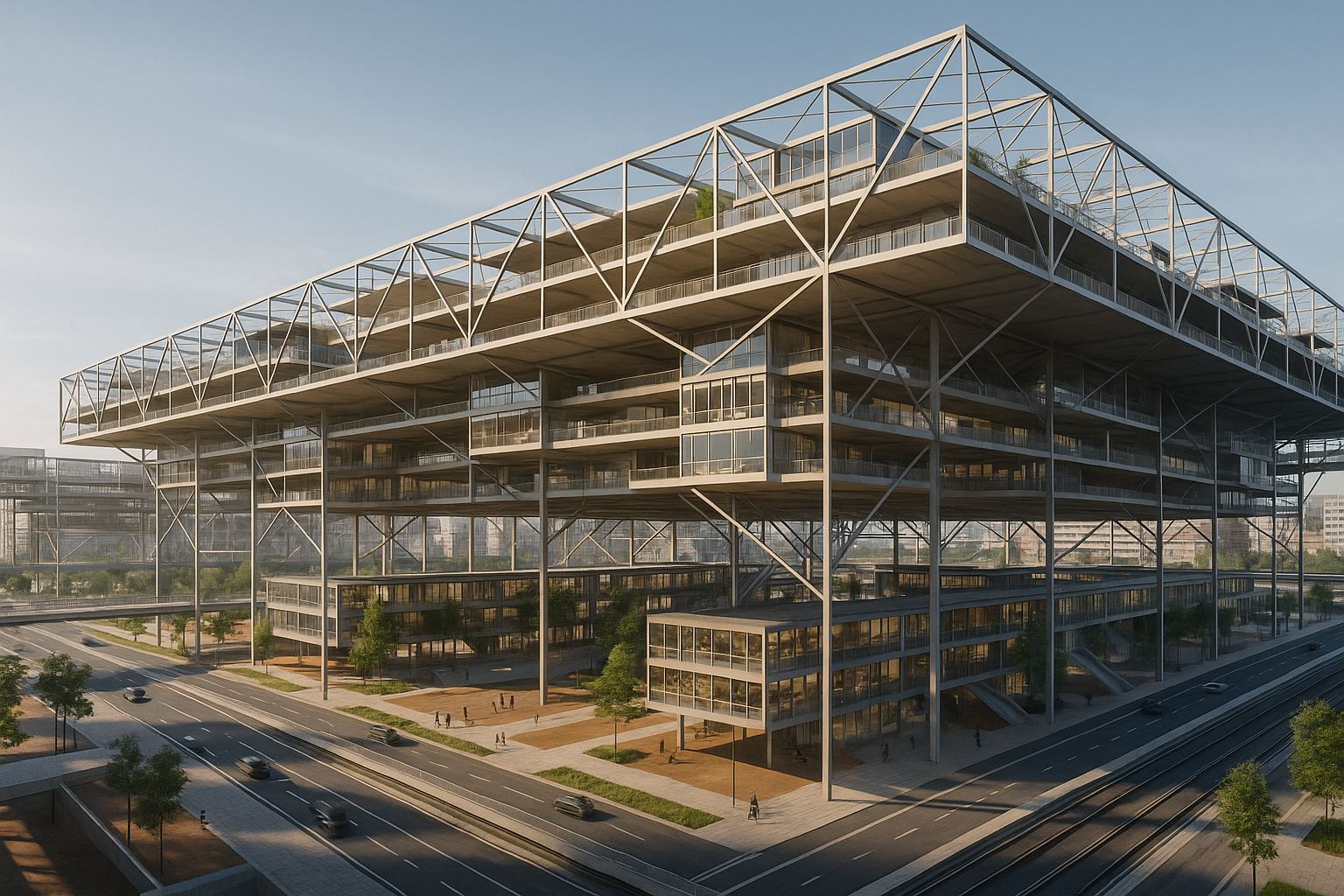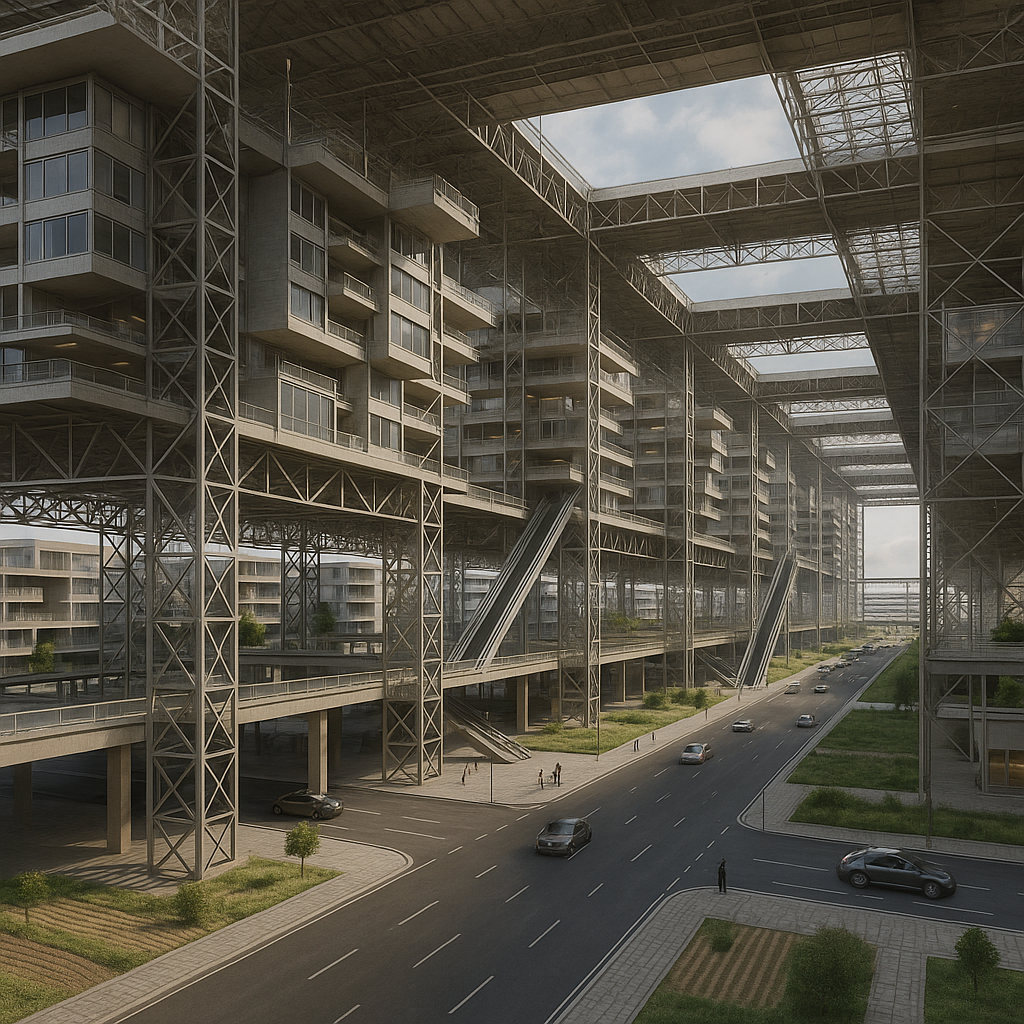Ville Satlale/ Cidade espacial de Yona Friedman
Principais características
Prompt positivo: Ultra-detailed 8K architectural visualization, eye-level perspective of the visionary “Ville Spatiale” (1958–1959) by Yona Friedman. The scene captures an immense elevated megastructure suspended above the existing urban fabric, embodying Friedman’s radical vision of mobility and spatial autonomy in the contemporary world. The superstructure unfolds in a spontaneous and modular manner, forming a multi-layered cityscape that floats above the ground plane — minimizing impact on the terrestrial surface while allowing for high urban density. The elevated grid is composed of lightweight steel frameworks and modular platforms, interconnected by walkways and access nodes. These elements support a flexible and evolving network of habitable units that respond dynamically to the population’s changing needs. The design embraces a non-hierarchical, adaptive urbanism — giving inhabitants full autonomy to shape their living environments. Captured in realistic atmospheric lighting with long shadows and volumetric depth, the image emphasizes transparency, structure, and vertical layering. Architectural materials include exposed steel lattices, translucent panels, and modular enclosures. The perspective reveals the coexistence of old and new urban layers — an architectural organism suspended above the city, both futuristic and humane.
Imagens produzidas pelo Chat GPT a partir de entradas de texto
Características formais
Prompt positivo: Ultra-detailed 8K architectural visualization, eye-level perspective of Yona Friedman’s visionary “Ville Spatiale” (1958–1959). The scene reveals a monumental, elevated megastructure suspended above the urban landscape, composed of a geometric three-dimensional grid derived from a minimal, repeatable spatial unit. This regularized structural lattice forms the backbone of the city — a framework that allows for open-ended urban composition, functioning like an enormous interlocking puzzle. The design emphasizes vertical development, with the urban mesh lifted four to six stories above the ground, supported by a network of tension cables and triangulated truss columns. Prefabricated slabs and lightweight enclosure elements are suspended within the grid, creating flexible spaces that can evolve according to inhabitant needs. The entire structure rises at least twelve meters above the ground, enabling it to hover over any existing city without disrupting the built environment below. This spatial city concept is exemplified in Friedman’s illustrations of Paris, yet its universal adaptability makes it ideal for contemporary cities seeking innovative strategies for vertical expansion. Rendered with atmospheric realism, the visualization highlights the interplay of structural clarity, modular repetition, and urban layering. Materials include steel trusses, tension cables, translucent panels, and prefabricated concrete floors. The environment is bathed in soft natural light, emphasizing depth, lightness, and spatial openness.
Prompt negativo: Low resolution, fantasy architecture, steampunk, gothic, medieval, brutalist, dystopian atmosphere, sci-fi spacecrafts, overly stylized, surreal elements.
Imagens produzidas pelo Chat GPT a partir de entradas de texto
Características de Infraestrutura de Mobilidade
Prompt positivo: Ultra-detailed 8K architectural visualization, eye-level perspective of Yona Friedman’s visionary “Ville Spatiale” (1958–1959). The image presents an elevated megastructure composed of modular spatial units, suspended high above the existing city on a geometric grid of steel trusses and prefabricated slabs. Vertical circulation is facilitated by external elevators and escalators, seamlessly integrated into the structural frame. Massive esplanades and high-speed transit corridors connect clusters of suspended structures, creating a vast, multilayered urban environment in the sky. Vehicles travel through a neutral central axis, while the architecture itself is conceived as mobile and reconfigurable — capable of being assembled, disassembled, and reassembled endlessly in any location. This radical flexibility allows the city to adapt to changing needs and contexts without permanent imposition on the ground below. The visual captures the floating grid under atmospheric lighting, emphasizing its lightness, modular repetition, and infrastructural elegance. Materials include exposed steel frameworks, translucent closure panels, tension cables, and modular floors. The ambiance is serene yet futuristic, with long shadows and layered depth enhancing the monumental yet open-ended character of the structure.
Prompt negativo: Low resolution, fantasy or surreal architecture, cyberpunk, steampunk, brutalist, dystopian, sci-fi aliens, medieval, neon lights, chaotic environment.
Características dos Espaços Verdes
Prompt positivo: Ultra-detailed 8K architectural visualization, eye-level perspective of Yona Friedman’s visionary “Ville Spatiale” (1958–1959). The scene reveals a vast, elevated urban structure composed of a modular three-dimensional grid suspended above the ground. At the heart of this airborne city lies a spacious esplanade — an open, elevated platform designed as a social interface for human interaction, exchange, and daily life. This esplanade functions as a communal hub, connecting the surrounding spatial units through walkways, escalators, and elevators. The lightweight megastructure is constructed from triangulated steel trusses, tension cables, and prefabricated slabs, offering flexibility, minimal ground impact, and modular adaptability. Floating above the existing urban fabric, the city allows for vertical expansion and continuous reconfiguration. The atmosphere is rendered in natural daylight with high-fidelity textures, emphasizing the openness of the elevated platform, the rhythm of the structural grid, and the human-scale dimension of the esplanade. Materials include exposed steel frames, translucent panels, and modular concrete flooring. The composition highlights the utopian ideal of dynamic, mobile, and socially active urban life suspended in space.
Prompt negativo: Low resolution, cartoon, dystopian, fantasy, steampunk, gothic, brutalist, chaotic, neon-lit, sci-fi spacecrafts, post-apocalyptic scenery.
Imagens produzidas pelo Chat GPT a partir de entradas de texto
Características Espaciais e Funcionais
Prompt positivo: Ultra-detailed 8K architectural visualization, eye-level perspective of Yona Friedman’s visionary “Ville Spatiale” (1958–1959). The image showcases a monumental megastructure elevated approximately twelve meters above the ground, composed of a modular spatial grid rising four to six stories high. This superstructure supports a stratified zoning system that organizes the city vertically: residential units occupy the uppermost layers, offering customizable layouts through architectural “hardware” — a flexible design toolkit that allows users to shape their living spaces according to personal needs. The intermediate layers accommodate commercial zones with shops, services, and public amenities. The ground level beneath the raised city supports light industrial and agricultural functions, integrating production with urban life while preserving the land’s original footprint. The scene reveals an interconnected, elevated cityscape of housing, schools, offices, terraces, and leisure spaces — all suspended in a harmonious, modular framework of steel trusses, prefabricated slabs, and translucent enclosure systems. Natural daylight enhances the clarity of the urban layering and the logic of the zone distribution. The architecture expresses lightness, adaptability, and autonomy — a city in the sky designed to evolve alongside its inhabitants.
Prompt negativo: Low resolution, fantasy architecture, medieval, brutalist, dystopian, cyberpunk, neon colors, chaotic design, surreal elements, post-apocalyptic ruins.
Imagens produzidas pelo Chat GPT a partir de entradas de texto
Todos os prompts anteriores.
Prompt positivo: Ultra-detailed 8K architectural visualization, eye-level perspective of Yona Friedman’s visionary “Ville Spatiale” (1958–1959). The image captures a monumental elevated megastructure, suspended approximately twelve meters above the existing urban fabric. This three-dimensional modular grid is derived from a repeatable minimal spatial unit, forming the structural backbone of a city designed for vertical growth, adaptability, and autonomy. Rising four to six stories high, the superstructure supports a stratified zoning system: the upper layers house customizable residential units configured through architectural hardware, allowing inhabitants to design their own spatial layouts. Intermediate levels contain commercial zones — shops, services, and public facilities — while the ground level accommodates light industrial and agricultural activities, integrating production into the urban cycle with minimal land impact.
Vertical circulation is enabled by elevators and escalators seamlessly embedded into the structural frame, while vast esplanades serve as communal hubs for human exchange. These are interconnected by pedestrian walkways and high-speed transit corridors, reinforcing the city’s dynamic, multilayered spatial logic. Vehicles travel through a central neutral axis, and the entire structure is conceived as reconfigurable — capable of being assembled, disassembled, and relocated indefinitely to meet shifting urban demands. Materials include exposed steel trusses, tension cables, prefabricated concrete slabs, and translucent enclosure panels. Rendered under atmospheric natural lighting with long shadows and volumetric depth, the composition emphasizes modular repetition, structural elegance, and the coexistence of historical urban strata with futuristic floating infrastructure. The Ville Spatiale emerges as a spatial organism — visionary, mobile, and inherently human.
Prompt negativo: Low resolution, fantasy, cartoon, cyberpunk, steampunk, medieval, brutalist, dystopian, neon lights, retro-futuristic, surreal, post-apocalyptic.
Imagens produzidas pelo Chat GPT a partir de entradas de texto
